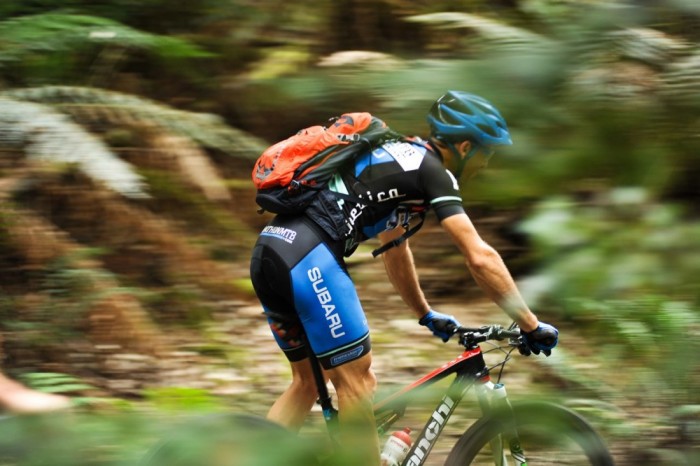Although I would like to say I’m a self-sufficient and could go into the wilderness on a six-hour epic and return having survived by squeezing water from rocks and eating snake meat, I must admit that I do require a few more ‘cushy’ survival necessities when I go for a ride.
Getting the right backpack is useful not just for training, but for the races where you need it! BITD at Trans Germany.
A couple of bottles of drink, some food and just enough spares to satisfy my pessimistic side has me set for a few hours in the hill. Usually I try to pack all this into my pockets, but when they start overflowing, I turn to a backpack. I have two options that I switch between, my four-year-old Camelbak Mule N.V and my newer Osprey Rev 12. Both are great backpacks with great features. In a side-by-side contest, the Camelbak does come out on top but I still find myself reaching for the Osprey regularly just because of a few choice features.
So what does make a good riding pack? What features are needed to keep you surviving in the wilderness, or maybe just surviving in more comfort?
Durability – As I mentioned before, I’ve had my Camelbak for over four years and apart from the colour fading it’s as good as new. With rugged material and quality stitching, it’s easy to see why. It will be interesting to see how the Osprey fairs as it seems to be made from a much thinner material, although this does make it a fair bit lighter, which can enhance the fit.
Fit – As with most accessories, if you forget the pack is there, it’s doing a good job. The back panel is the major difference between the two, with the CamelBak having my preferred ‘off the back’ style with mesh over foam pads that allows the air to flow up and around the back for breathability. On the other side, the Osprey has my preferred straps with a breathable mesh and fancy pockets that can hold your phone and some smaller items like a bar or multi tool. The Osprey also has a better harness system with three connecting straps spreading the load, as opposed to the Camelbak’s more traditional two straps. When looking for a new backpack, it’s important to try the bag on to make sure the fit matches with your body type, particularly look for male and female options. Even asking the shop if you can place some items inside the bag, can help give you a better idea on the fit.
Pockets – Camelbak also has my preferred option here with a lot more compartments to hold everything. This does result in more material and hence more weight than the Osprey. The fewer compartments in the Osprey affect the way the contents sit in the pack. In the Osprey everything gets dumped into three big pockets. Due to it’s thinner material this means the contents have a tendency to move around which is a bit of a pain on single track when your upper body is moving a lot.
Ultimately, when buying a pack you need to consider what you’re going to use it for. Lots of features are great but if you’re not going to use any of them, you’re just carrying around extra weight. I haven’t spoken on the hydration features that really make these bags what they are as I prefer using a bottle and usually carry a few extra in the hydration compartment of the bag. My best advice would be to buy something sturdy with just enough compartments to hold everything you might carry. Above all else, it should sit comfortably so you don’t notice it and, of course, it should match your kit!
The Croc Trophy is one of many events where the right backpack can help your race.

